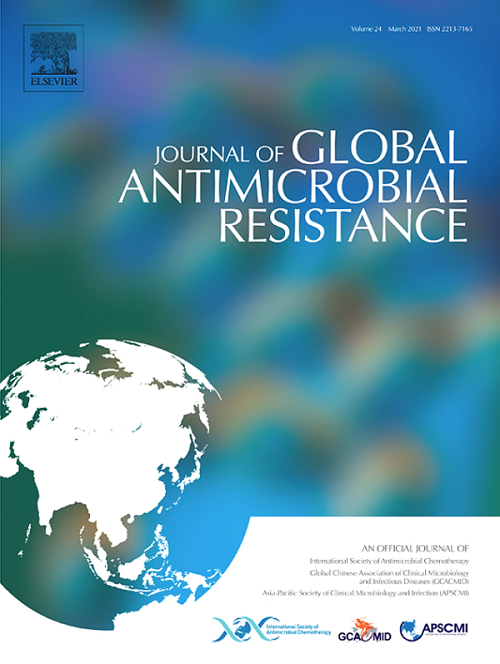Cefiderocol activity against planktonic and biofilm forms of β-lactamase-producing pseudomonas aeruginosa from people with cystic fibrosis
IF 3.2
3区 医学
Q2 INFECTIOUS DISEASES
引用次数: 0
Abstract
Objectives: Chronic Pseudomonas aeruginosa infections are a leading cause of acute pulmonary exacerbations in people with cystic fibrosis (pwCF). Intrinsic antibiotic resistance and biofilm formation complicate treatment. This study investigates the genomic diversity and cefiderocol efficacy against planktonic and biofilm-associated forms of P. aeruginosa isolates from pwCF.
Methods: Eight P. aeruginosa clinical isolates and three laboratory strains underwent whole genome sequencing (WGS). Biofilm formation was assessed through biomass, cell count, metabolic activity, and extracellular DNA (eDNA). The minimum bactericidal concentration (MBC90) and biofilm eradication concentration (MBEC90) were also determined.
Results: WGS revealed significant genomic diversity, identifying ten distinct sequence types (STs). Antibiotic susceptibility testing (AST) showed that 10/11 strains were susceptible to cefiderocol, with one isolate (MPA9) displaying resistance linked to the blaOXA486 gene. Adding the β-lactamase inhibitor avibactam (AVI) restored susceptibility in this resistant strain. Although iron metabolism genes were highly conserved across isolates, MPA9 lacked the fpvA iron receptor, potentially contributing to cefiderocol resistance. Biofilm formation significantly increased tolerance to cefiderocol, with an 8-fold rise in MBEC90 compared to MBC90.
Conclusion: These findings highlight the genomic diversity and adaptive potential of P. aeruginosa in pwCF. Cefiderocol shows promise against planktonic and biofilm-associated P. aeruginosa, and combining it with AVI may counteract β-lactamase-mediated resistance.
头孢地罗对囊性纤维化患者产生β-内酰胺酶的铜绿假单胞菌浮游和生物膜形式的活性。
目的:慢性铜绿假单胞菌感染是囊性纤维化(pwCF)患者急性肺恶化的主要原因。固有的抗生素耐药性和生物膜的形成使治疗复杂化。本研究研究了从pwCF分离的铜绿假单胞菌浮游和生物膜相关形式的基因组多样性和头孢地罗col的功效。方法:对8株铜绿假单胞菌临床分离株和3株实验室菌株进行全基因组测序。通过生物量、细胞计数、代谢活性和细胞外DNA (eDNA)来评估生物膜的形成。测定了最小杀菌浓度(MBC90)和生物膜根除浓度(MBEC90)。结果:WGS显示了显著的基因组多样性,鉴定出10种不同的序列类型(STs)。药敏试验(AST)显示,10/11株菌株对头孢地罗敏感,其中1株(MPA9)与blaOXA486基因连锁。添加β-内酰胺酶抑制剂阿维巴坦(AVI)恢复了该耐药菌株的敏感性。尽管铁代谢基因在分离株中高度保守,但MPA9缺乏fpvA铁受体,可能导致头孢地罗耐药。生物膜的形成显著增加了对头孢地罗的耐受性,与MBC90相比,MBEC90增加了8倍。结论:这些发现突出了铜绿假单胞菌在pwCF中的基因组多样性和适应潜力。Cefiderocol对浮游生物和与生物膜相关的P. aeruginosa有良好的治疗前景,与AVI联合使用可能会抵消β-内酰胺酶介导的耐药性。
本文章由计算机程序翻译,如有差异,请以英文原文为准。
求助全文
约1分钟内获得全文
求助全文
来源期刊

Journal of global antimicrobial resistance
INFECTIOUS DISEASES-PHARMACOLOGY & PHARMACY
CiteScore
8.70
自引率
2.20%
发文量
285
审稿时长
34 weeks
期刊介绍:
The Journal of Global Antimicrobial Resistance (JGAR) is a quarterly online journal run by an international Editorial Board that focuses on the global spread of antibiotic-resistant microbes.
JGAR is a dedicated journal for all professionals working in research, health care, the environment and animal infection control, aiming to track the resistance threat worldwide and provides a single voice devoted to antimicrobial resistance (AMR).
Featuring peer-reviewed and up to date research articles, reviews, short notes and hot topics JGAR covers the key topics related to antibacterial, antiviral, antifungal and antiparasitic resistance.
 求助内容:
求助内容: 应助结果提醒方式:
应助结果提醒方式:


